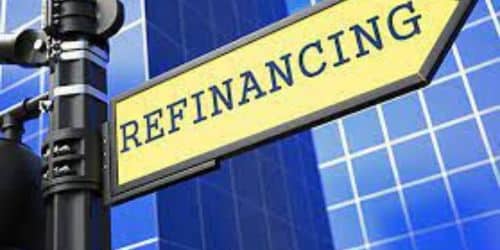The process of getting a new loan to pay off one or more existing loans is referred to as loan refinancing. Refinancing is typically done by borrowers to cut their interest rates or otherwise lessen their repayment obligations. Refinancing is another way for borrowers who are having trouble making their payments to obtain a loan with a longer term and lower monthly installments. In the course of this post, we shall discuss how to refinance a loan which includes student loans with bad credit.
Refinance a Loan
With a loan refinance, you can swap out your current loan for a new one that might have a different interest rate or repayment schedule. If you need to prolong the length of your payback period or if your credit score has increased and you can now get a more favorable interest rate, refinancing can be a suitable option.
You’ll pay less for your personal loan as a whole if you refinance and are able to secure a lower interest rate. Lower minimum monthly payments are offered when refinancing to a longer loan term. By extending the repayment period due to interest charges, you will most likely pay more toward the loan altogether.
What Does it Mean to Refinance a Loan?
Refinancing a personal loan is applying for a new loan, either from the same lender or a different one, and using the money you receive to pay off the previous one. You will start making payments on your new loan with a new interest rate and terms as soon as the procedure is finished.
How Refinancing Your Personal Loan Can Affect Your Credit
Lenders frequently allow you to prequalify for a new personal loan without affecting your credit score. The decision to proceed with the loan will, however, result in a hard credit inquiry, which will temporarily lower your credit score. This could make it more difficult for you to obtain fresh credit after refinancing your personal loan. Your credit score will ultimately improve if you continue to make debt payments (and eventually pay it off).
How to Refinance a Loan
Whenever you are prepared to refinance your loan, start by taking the next few steps.
#1. Figure Out How Much Money You Need
When you refinance a loan, you effectively replace the old one with a new one that has different terms to pay off the old one. Therefore, ascertain the precise sum of money needed to pay off your current loan before requesting bids. Also, check to determine if there are any prepayment penalties levied by your original lender that would negate the advantages of refinancing.
#2. Check your Credit Report and Score.
Check your credit score and credit report before thinking about refinancing your loan. This is an essential step to determine whether you are eligible for a rate that is lower than the one you are currently paying. It might not be advantageous to refinance if the new interest rate is not much lower.
#3. Visit Banks and Online Lenders to Compare Rates and Terms.
Personal loan refinancing requires thorough research; before refinancing, examine rates and terms from various lenders. It’s crucial to compare shops because different lenders may offer you a different interest rate and set of terms. Additionally, a new loan with a lower interest rate may not be preferable if you end up spending more in fees overall or extending it unnecessarily.
#4. Contact Your Current Lender.
While conducting your study, don’t forget about your present lender. In order to keep your business, it might be willing to provide you with a better deal than your current loan. It might be simpler to learn if you can qualify for a new loan because you already have a relationship with your present lender; frequently, it won’t even need running a new credit report.
#5. Request a Loan
Once you’ve chosen the lender whose offer you prefer, submit your application and any supporting documentation that may be needed, such as your Social Security number, paystubs, bank statements, or tax returns. A formal refinancing application is not the same as the loan comparison phase that was explained earlier. You must submit a formal application in order to proceed with a loan offer, go through the loan underwriting procedure, and get cash from your selected lender.
#6. Start Paying Back Your New Loan.
You will pay off your current loan once you get the proceeds from your new loan. To avoid paying double loan payments or extra interest, this should be completed as quickly as feasible. You begin your new loan’s payback period as soon as you receive the amount you requested. With your new interest rate, new repayment period, and new monthly payment amount, you’ll start making monthly payments right now.
Refinance a Loan With Bad Credit
Follow these few steps to refinance a loan with bad credit:
#1. Try Your Own Mortgage Lender First
The goal of mortgage lenders is to establish connections with borrowers. If you want to refinance but you have low credit, you will need to take some time to discover a solution that fits your particular financial situation. Since you are currently a client of your current lender or loan servicer, that is where you should start. Don’t give up on refinancing your mortgage if you have bad credit. There are mortgage lenders willing to cooperate with those with low credit scores. This includes mortgage firms, online lenders, and reputable conventional brick-and-mortar banks like U.S. Bank that work with clients with weak credit.
#2. Check Out an FHA Streamline Refinance
The FHA streamline refinance program can be a fantastic choice if you need to refinance and have an FHA loan. According to the U.S. Department of Housing and Urban Development, the average credit score of a borrower who refinanced an FHA loan between October and December of 2021 was 657. The required credit score to refinance is 580. However, lenders may authorize refinancing for customers with credit scores as low as 500 who also have a home equity of at least 10%.
#3. Explore an FHA Rate-and-Term Refinance
Any borrower may apply for an FHA rate-and-term refinance, even though an FHA streamlined refinance is only available to current FHA borrowers. If your mortgage has a high-interest rate, you may find it advantageous to do so. A new appraisal, a credit check, and the requirement that the mortgage being refinanced be current for the month due all add to the process’ additional paperwork.
#4. Apply for a VA Streamline Refinance or a VA-Backed Cash-Out Refinance Loan
With a no-hassle Interest Rate Reduction Refinancing Loan (IRRRL), commonly referred to as a VA streamlined refinancing, you can refinance an existing VA-backed home loan even if you have poor credit. IRRRLs often demand that you submit financial documents like your most recent pay stubs, two years’ worth of W-2s, and federal income tax returns. This option’s lenders will also demand a home appraisal.
#5. Use the USDA Streamlined Assist Program
Because there isn’t a credit check necessary, the USDA’s Streamlined Assist program may be the best choice for a refinance with negative credit if you qualify. Instead, anyone who has paid all of their mortgage payments over the last 12 months on time and has a loan via or supported by the USDA is eligible.
#6. Consider a Portfolio Refinance Loan
A portfolio loan is another refinancing choice if you have poor credit. Through banks and mortgage brokers, you can receive a portfolio loan, so named because the original lender holds (and frequently services) the loan rather than selling it to another party. The lender sets its own rules for the loan, which may be more lenient than conventional refinance requirements. If you’ve been a long-time mortgage or bank customer, or if the lender wants your business, you’re more likely to get approved for a portfolio loan.
#7. Locate a Co-Signer
Obtaining a co-borrower might drastically improve your situation if poor credit is keeping you from refinancing and locking in a reduced rate. Even among relatives or friends, co-signing a mortgage is a commercial transaction. The lender has more security if the co-signer has good credit and substantial financial resources. You must persuade your co-signers that you have the financial means to repay the loan and that you will prioritize repaying it over other responsibilities because they worked hard to earn their money and credit.
Refinance Student Loans
The process of getting a new loan to pay off your old student loans is known as student loan refinancing. You might be eligible for a reduced interest rate and a different repayment schedule when you refinance your student loans, which might help you save money on interest or cut your monthly payments. Both federal and private student loans are refinancingable, but it’s generally preferable to avoid refinancing federal loans because they have a number of benefits that aren’t offered by private lenders.
Should I Refinance my Student Loans?
Only if the loan you seek has a lower interest rate than the loan you already have make financial sense to refinance your student loans. To compare your current monthly payment to that of the loan you are contemplating, utilize a loan calculator. Although you might choose to refinance to a longer term to lower your monthly payments, be aware that doing so will probably result in an increase in your loan’s total cost due to interest accrual.
The kind of loans you have will also influence whether you should refinance. If you have private loans, refinancing can make sense, but if you refinance federal loans, you’ll forfeit benefits.
Best Student Refinance Loans Lenders
#1. Sofi
It’s understandable why SoFi is one of the most well-liked lenders for refinancing student loans. This lender provides loans with affordable interest rates and no origination or other hidden expenses. SoFi is a wonderful option for many different sorts of borrowers due to its wide range of payback options, low rates, and selection of online resources.
#2. Earnest
With Earnest, you can refinance your student loans and possibly receive a low APR and flexible repayment terms. Finding a repayment schedule that fits your budget is simple with maturities ranging from five to twenty years. Earnest allows you to choose a payment that works with your budget and will adjust the loan’s term until you find a monthly amount you can manage. If you require some breathing room, you may also choose to miss a payment once every 12 months.
#3. Citizens Bank
Although maximums vary depending on your degree type, this bank offers student loan refinancing for individuals who need to refinance up to $750,000 in student loans. Depending on your degree type, variable financing rates as low as 5.39 percent APR are also available, and you can choose a repayment period between five and twenty years. You may be eligible for a number of discounts, such as the automatic payment discount and the loyalty discount, which can lower your interest rate. Your APR may be reduced by 0.5 percent as a result of these incentives, helping you to save even more money over time.
#4. Splash Financial
You can refinance your debts here for a sum ranging from $5,000 to their entire value. Although it doesn’t provide money directly, it works with other lenders to find a lender that can fulfill your needs and your financial status. Splash claims some of the lowest rates for student loan refinancing for customers with good credit because it works with a range of lenders.
#5. College Ave
College Ave is a good option to consider if you want to refinance your student loans without paying any fees. If you have a doctorate in medicine, dentistry, pharmacy, or veterinary medicine, this lender provides variable and fixed rates as low as 5.99 percent APR, and you can refinance up to $300,000 in student debt. The maximum loan amount for any other degree is $150,000. The only fee you might have to pay is a late fee; this lender doesn’t impose any upfront fees for its loans.
Do You Get Money When You Refinance a Loan
A cash-out refinance is a type of mortgage refinancing that enables you to cash out your home equity. Your prior mortgage balance is exceeded by the amount of the new mortgage, and the excess is paid to you in cash.
Can You Refinance a Personal Loan
You can, in fact, restructure a personal loan to obtain a lower interest rate or a more manageable monthly payment. Simply taking out a new loan to pay off the old one is how you refinance a personal loan, giving you a new rate and repayment period.
Does Refinancing Mean You Pay Longer?
Refinancing frequently results in lower interest rates. In order to pay off their loans more quickly, borrowers also refinance them. Longer terms may allow for cheaper monthly payments, but because of the additional time the loan spends racking up interest, they also come at a larger overall cost.
What Is the Most Common Reason to Refinance?
Reduce the interest rate. This is the most typical justification for refinancing, also referred to as a “rate-and-term” refinance. If the arithmetic works out, borrowers with a higher interest rate on their current loan might gain by refinancing, particularly if they’re shortening the loan term.
What Are the Benefits and Risks of Refinancing?
- Pro: You can almost certainly lock in a lower interest rate.
- Con: The savings might not be substantial, depending on your present rates.
- Pro: A 30-year term could be converted to a 15-year term at this point.
- Cons: It takes time to refinance.
- Pro: You might be able to use the equity you’ve built to get cash.
Related Posts
- WHEN SHOULD YOU REFINANCE YOUR CAR? Is It Ever a Good Idea to Refinance Your Car?
- HOW MANY TIMES CAN YOU REFINANCE YOUR HOME: Updated
- BEST AUTO REFINANCE LOAN COMPANIES IN 2023.
- How Much Does It Cost To Refinance Mortgage In 2023
- HOW SOON CAN YOU REFINANCE A MORTGAGE IN 2023?






